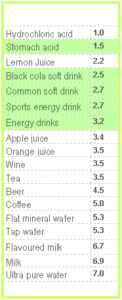What is acid wear and how does it impact your teeth?
Acid wear is a form of tooth wear. It is caused by the surface of the tooth’s enamel softening from eating or drinking something acidic.
When tooth enamel (the tooth’s hard surface) is exposed to acids (from food, drinks or the stomach), it temporarily softens and loses some of it’s mineral content. Saliva will help neutralise acidity, restore the mouth’s natural balance and slowly harden the tooth enamel. However, because the tooth’s recovery process is slow, if the acid attack happens frequently, the tooth does not have a chance to repair.
Measuring the levels of acid in food and drinks
pH is a measure of how acidic or alkaline a substance is. The pH scale ranges from 1 to 14, with 1 being very acidic, 7 neutral and 14 very alkaline. Acid wear can start at a pH of 5.0 or below.
The pH of some common liquids are:
The impacts of acid wear on your smile
The wear caused by acid erosion can lead to reduced thickness of enamel and a change in texture, shape and appearance of teeth. Early signs include, sensitivity, discolouration and rounded teeth.
How to prevent acid wear
- Consume acid-containing foods and drinks quickly to limit the time they are in contact with your teeth.
- Drink acidic drinks through a straw, and don’t hold the liquid in your mouth or swish it around.
- Drink plenty of water to maintain hydration levels.
- Avoid brushing your teeth straight after consuming acid-containing meals or drinks as this is when your enamel is at it’s softest.
- After an acidic meal, consider eating some enamel friendly foods such as cheese and nuts to help restore the pH balance in your mouth.
- Use a toothpaste that contains fluoride with a soft-bristled tooth brush to gently clean your teeth.
- See your dentist for a check up every 6-12 months.
Can acid wear be reversed?
Once the damage has been done it can not be reversed. In the advanced stage of acid wear there is likely to be a need for expensive and complicated dentistry to restore teeth to normal function. This is why understanding the problem and taking steps to minimise risks is so important.





